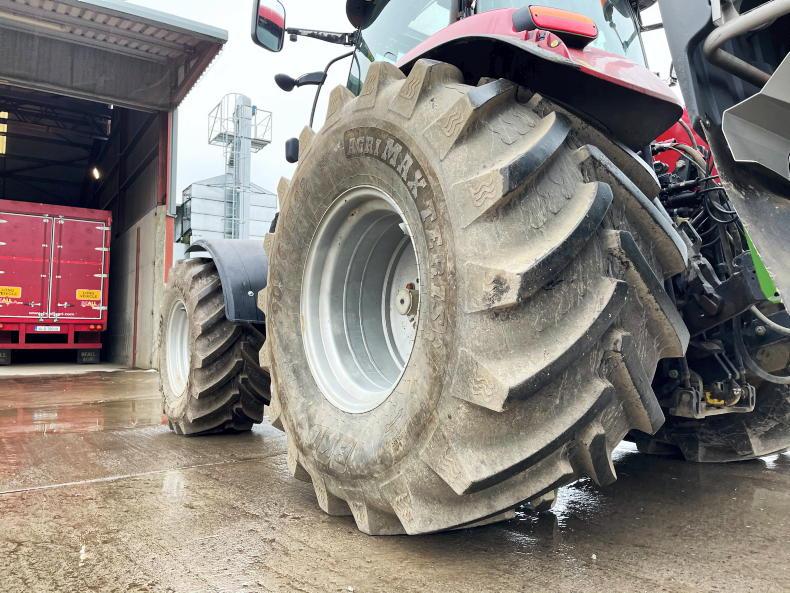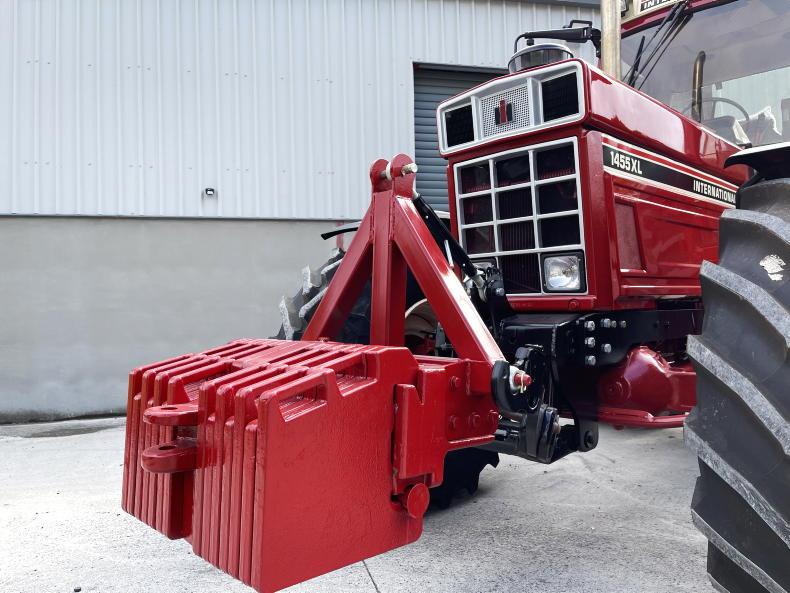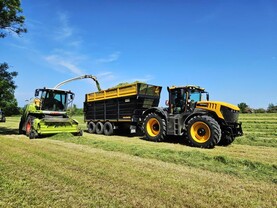Taking the time to correctly ballast a tractor and set tyre pressures for a particular task provides a greater benefit than one might think.
A tractor correctly set up for the job intended will benefit from fuel savings, improved tyre wear, greater traction and reduced soil compaction.
Ballast requirements tend to vary quite a bit depending on implement type, ie mounted, semi-mounted or trailed via drawbar.
For example, a mounted implement will transfer weight on to the tractor via the top links, reducing the degree of ballast weight required.
Tractors operating semi-mounted or trailed implements must be ballasted to efficiently pull the implement as the degree of weight transferred to the tractor is significantly reduced.
Initial preparation
First and foremost, you need to ensure that the tractor has the required weight rating to handle the implement in mind. This will generally be printed on the tractor’s serial plate.
If this is not clear to be seen, its rating will be found online or by contacting the dealer.

Determining axle loads allows the correct tyre pressures to be set using inflation tables. \ Barry Cronin
If you are not familiar with the tractor’s weight, it is advisable to weigh the tractor – ideally with a half tank of diesel.
Weigh the front and rear axle too to calculate weight distribution ratios. This information allows any necessary calculations to be done to find the correct or additional ballast weight required or needing to be removed.
Know the weight that your tyres are rated for. Tyres will need to be rated for the tractor’s operational weight plus the additional weight of the implement and ballast required.
Weight distribution
Weight distribution is key for optimum traction and fuel efficiency.
The majority of tractors under 200hp tend to have a 60:40 weight distribution leaving the factory, while larger tillage tractors designed more so for heavier draft applications have a 50:50 weight distribution.
It is important that these ratios are maintained for optimum performance.
A well-ballasted tractor should see wheel slip ranging between 8% and 12% increasing to 15% to 20% in sandy soils.
This is important to get right as too much ballast can increase fuel consumption and cause soil damage. Too little ballast will allow too much wheel slip, causing premature tyre wear and increased fuel consumption.

Fitting wider tyres allow a bigger contact patch meaning a given load can be carried at a lower inflation pressure.
A tractor fitted with mounted implement, ie one-pass or plough, may only require an additional front ballast to keep weight on the front axle and maintain control of steering during transport.
Given that more weight will be placed on the rear axle during transport, tyre pressures may need to be set differently too – depending on transport distance, a slight compromise may have to be made.
In an ideal scenario, pressures should be adjusted accordingly for transport and field work, this being the benefit of a central tyre inflation system which we see manufacturers such as Fendt offering.

Manufacturers such as Fendt now offer central inflation systems where by tyre pressure can be adjusted on the fly for either field or transport conditions.
If field tyre pressure cannot be inflated for transport it is advised that the tractor and implement are transported at slow speeds to prevent tyre sidewalls from overheating.
Front and rear ballast
To many, the fitment of a front ballast weight is the answer to all problems – which it is not. In many cases where there is no draft weight transferred to the tractor from the implement, too much front weight can be pointless and even counterproductive.
What many people don’t realise is, when ballast weight is added in front of or behind an axle, weight is then transferred from the other axle.
With weight blocks or traditional suitcase-type weights, weight transfer occurs as the axle is a pivot point – think of the seesaw analogy.
In other words, 500kg on a tractor’s front linkage will in actual fact have more effect than 500kg compared to 500kg placed on the tombstone.
This is because the weight is placed further away from the front axle with front linkage. Ideally, this needs to be accounted for and can be easily calculated if there is no weighbridge handy.
Dividing the distance the front ballast is from the centre of the front axle in millimetres (mm) by the tractor’s wheelbase (also mm) will give you the total weight placed on the front axle, including the ballast weight. Then multiply this figure by the weight of the front ballast in kilos. The answer is the amount of weight in kilos removed from the tractor’s rear axle.
Now add this figure to the weight of the front ballast and you will get the accurate weight placed on the front axle.
To rebalance the tractor, reduce this weight and or add weight to the rear axle by means of rear ballast, keeping in mind the maximum axle and tyre loading of the tractor.
Weight transfer does not occur with wheel weights as the weight is placed directly on the rear axle.
Cast weights or water
Traditionally, many operators looking to add weight would have filled tyres with water – a cheaper solution to wheel weights. While water may have been convenient and suited older cross ply tyres, it prevents modern radial tyres from flexing as they are designed to.
Modern VF and IF tyre technology and water ballasting don’t go well together.

IF and VF tyres can carry between 20% and 40% more load at the same pressure compared to standard tyres.
VF and IF tyre sidewalls are designed for high flexion and low operating pressures. Adding water to these tyres not only inhibits these characteristics but counteracts the investment and potential benefits.
Wheel weights are more common now due to modern tyre technology and the fact manufacturers have better/faster ways and means of wheel weight installation and removal.
Although not recommended by most tyre manufacturers, if using water as additional ballast ensure that anti-freeze is added to prevent the tyre(s) from bursting in the event of frost.
For reference, a 650/65 R38 tyre will hold in the region of 630 litres of water.
Inflation pressure is a good guide to ground pressure, as it is the air within a tyre which supports the load.
Ground pressure can be reduced by lowering inflation pressure once the level of deflection allowed by the manufacturer (usually about 20%) is not exceeded. Otherwise, the tyre’s side walls will likely be subject to damage.

The further the ballast weight is away from the axle the greater actual effect it has.
The level of tyre deflection allowed depends on the type of tyre carcase construction and the operating speed – less deflection is allowed at higher speeds. IF and VF tyres allow an increased level of deflection and for their size can carry a load at lower inflation pressures and reduced ground pressures.
The goal when setting tyre pressures is to have just enough pressure to carry the required axle load. This includes the weight of the tractor, any ballast added and the implement weight being carried by the linkage or drawbar.
As mentioned earlier, a weighbridge is the best method of getting the total weight of each axle. Having got this you can work out the required inflation pressures from the load and inflation tables.
Correctly ballasting a tractor will take time initially. However, calculations will only need to be made once for a particular implement.Determining axle loads allows the correct tyre pressure to be set. IF and VF tyres can carry approximately 20% and 40% more load at the same inflation pressure than a standard tyre of the same dimensions.If unsure, refer to your dealer or tyre supplier for the necessary advice.
Taking the time to correctly ballast a tractor and set tyre pressures for a particular task provides a greater benefit than one might think.
A tractor correctly set up for the job intended will benefit from fuel savings, improved tyre wear, greater traction and reduced soil compaction.
Ballast requirements tend to vary quite a bit depending on implement type, ie mounted, semi-mounted or trailed via drawbar.
For example, a mounted implement will transfer weight on to the tractor via the top links, reducing the degree of ballast weight required.
Tractors operating semi-mounted or trailed implements must be ballasted to efficiently pull the implement as the degree of weight transferred to the tractor is significantly reduced.
Initial preparation
First and foremost, you need to ensure that the tractor has the required weight rating to handle the implement in mind. This will generally be printed on the tractor’s serial plate.
If this is not clear to be seen, its rating will be found online or by contacting the dealer.

Determining axle loads allows the correct tyre pressures to be set using inflation tables. \ Barry Cronin
If you are not familiar with the tractor’s weight, it is advisable to weigh the tractor – ideally with a half tank of diesel.
Weigh the front and rear axle too to calculate weight distribution ratios. This information allows any necessary calculations to be done to find the correct or additional ballast weight required or needing to be removed.
Know the weight that your tyres are rated for. Tyres will need to be rated for the tractor’s operational weight plus the additional weight of the implement and ballast required.
Weight distribution
Weight distribution is key for optimum traction and fuel efficiency.
The majority of tractors under 200hp tend to have a 60:40 weight distribution leaving the factory, while larger tillage tractors designed more so for heavier draft applications have a 50:50 weight distribution.
It is important that these ratios are maintained for optimum performance.
A well-ballasted tractor should see wheel slip ranging between 8% and 12% increasing to 15% to 20% in sandy soils.
This is important to get right as too much ballast can increase fuel consumption and cause soil damage. Too little ballast will allow too much wheel slip, causing premature tyre wear and increased fuel consumption.

Fitting wider tyres allow a bigger contact patch meaning a given load can be carried at a lower inflation pressure.
A tractor fitted with mounted implement, ie one-pass or plough, may only require an additional front ballast to keep weight on the front axle and maintain control of steering during transport.
Given that more weight will be placed on the rear axle during transport, tyre pressures may need to be set differently too – depending on transport distance, a slight compromise may have to be made.
In an ideal scenario, pressures should be adjusted accordingly for transport and field work, this being the benefit of a central tyre inflation system which we see manufacturers such as Fendt offering.

Manufacturers such as Fendt now offer central inflation systems where by tyre pressure can be adjusted on the fly for either field or transport conditions.
If field tyre pressure cannot be inflated for transport it is advised that the tractor and implement are transported at slow speeds to prevent tyre sidewalls from overheating.
Front and rear ballast
To many, the fitment of a front ballast weight is the answer to all problems – which it is not. In many cases where there is no draft weight transferred to the tractor from the implement, too much front weight can be pointless and even counterproductive.
What many people don’t realise is, when ballast weight is added in front of or behind an axle, weight is then transferred from the other axle.
With weight blocks or traditional suitcase-type weights, weight transfer occurs as the axle is a pivot point – think of the seesaw analogy.
In other words, 500kg on a tractor’s front linkage will in actual fact have more effect than 500kg compared to 500kg placed on the tombstone.
This is because the weight is placed further away from the front axle with front linkage. Ideally, this needs to be accounted for and can be easily calculated if there is no weighbridge handy.
Dividing the distance the front ballast is from the centre of the front axle in millimetres (mm) by the tractor’s wheelbase (also mm) will give you the total weight placed on the front axle, including the ballast weight. Then multiply this figure by the weight of the front ballast in kilos. The answer is the amount of weight in kilos removed from the tractor’s rear axle.
Now add this figure to the weight of the front ballast and you will get the accurate weight placed on the front axle.
To rebalance the tractor, reduce this weight and or add weight to the rear axle by means of rear ballast, keeping in mind the maximum axle and tyre loading of the tractor.
Weight transfer does not occur with wheel weights as the weight is placed directly on the rear axle.
Cast weights or water
Traditionally, many operators looking to add weight would have filled tyres with water – a cheaper solution to wheel weights. While water may have been convenient and suited older cross ply tyres, it prevents modern radial tyres from flexing as they are designed to.
Modern VF and IF tyre technology and water ballasting don’t go well together.

IF and VF tyres can carry between 20% and 40% more load at the same pressure compared to standard tyres.
VF and IF tyre sidewalls are designed for high flexion and low operating pressures. Adding water to these tyres not only inhibits these characteristics but counteracts the investment and potential benefits.
Wheel weights are more common now due to modern tyre technology and the fact manufacturers have better/faster ways and means of wheel weight installation and removal.
Although not recommended by most tyre manufacturers, if using water as additional ballast ensure that anti-freeze is added to prevent the tyre(s) from bursting in the event of frost.
For reference, a 650/65 R38 tyre will hold in the region of 630 litres of water.
Inflation pressure is a good guide to ground pressure, as it is the air within a tyre which supports the load.
Ground pressure can be reduced by lowering inflation pressure once the level of deflection allowed by the manufacturer (usually about 20%) is not exceeded. Otherwise, the tyre’s side walls will likely be subject to damage.

The further the ballast weight is away from the axle the greater actual effect it has.
The level of tyre deflection allowed depends on the type of tyre carcase construction and the operating speed – less deflection is allowed at higher speeds. IF and VF tyres allow an increased level of deflection and for their size can carry a load at lower inflation pressures and reduced ground pressures.
The goal when setting tyre pressures is to have just enough pressure to carry the required axle load. This includes the weight of the tractor, any ballast added and the implement weight being carried by the linkage or drawbar.
As mentioned earlier, a weighbridge is the best method of getting the total weight of each axle. Having got this you can work out the required inflation pressures from the load and inflation tables.
Correctly ballasting a tractor will take time initially. However, calculations will only need to be made once for a particular implement.Determining axle loads allows the correct tyre pressure to be set. IF and VF tyres can carry approximately 20% and 40% more load at the same inflation pressure than a standard tyre of the same dimensions.If unsure, refer to your dealer or tyre supplier for the necessary advice. 










 This is a subscriber-only article
This is a subscriber-only article









SHARING OPTIONS: